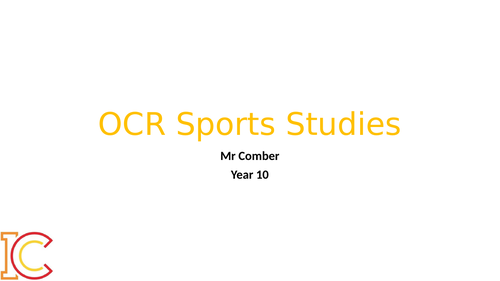
27Uploads
3k+Views
2k+Downloads
All resources

IB Sports, Health and Exercise Science - Unit 5 Skill in Sport, Part 2
This is a resource for IB Sports, Health and Exercise Science - Unit 5 Skill in Sport, Part 2. The learning objectives for this lesson is to outline ability, distinguish between Fleishman’s physical abilities , define the term technique, state the relationship between ability, skill and technique and discuss the differences between a skilled and novice performer.

IB Sports Health and Exercise Science - Information Processing, Part 3.
This is a resource for IB Sports, Health and Exercise Science, Information Processing, Part 3. The learning objectives for this unit is to describe a simple model of information processing, describe Welford’s model of information processing, outline the components associated with sensory input and explain the signal detection process.

IB Sports, Health and Exercise Science Unit Plan
This is a unit plan for IB Sports, Helath and Exercise Science for modules 1-6. This will help any teachers who are teaching the standard level course. It is linked to the IB learner profile.

Pre-school and Primary P.E Scheme of Work
When teaching pupils aged 3 to 6, I found it difficult to teach them fundamental movements. I did not have any ideas of how I could help them with their learning in P.E. After teaching early years and primary children P.E for over five years, I have an excellent understanding of how to teach them the fundamental principles. This step by step guide is easy to read and will help you to cover all aspects of the early years P.E curriculum. The learning objectives have been differentiated to help pupils achieve in P.E.

Components of Fitness
This is a resource for the components of fitness for GCSE P.E AQA specficiation. This PowerPoint gives practical examples of how to relate the components of fitness to sporting activities.

New IGCSE P.E Assessment Specification.
The new IGCSE P.E assessment specification is broken down into manageable sections, so pupils understand what they need to learn for each topic. The assessment grade criteria at the bottom of the resource can be used to accumulate students grades for IGCSE P.E.

Gymnastics Worksheet
This is a wonderful resource for creating your own sequences and routines in gymnastics. It features a role, balance and jump.

Fitness Tests
This is a PowerPoint presentation that can be used for fitness week. It has different fitness tests, which can be used in P.E lessons, GCSE P.E, A-Level P.E and BTEC Sport.

IB Sports Health and Exercise Science - Unit 5, Skill in Sport Part 1
This PowerPoint presentation is for the IB Sports, Health and Exercise Science. The unit covered in the PowerPoint is Unit 5 Skill in Sport. This is the first lesson Part 1. The PowerPoint includes the definition of skills, the types of skill, classifications of skill and the contrast of two types of skill.

IB Sports, Health and Exercise Science - Memory, Part 4
This PowerPoint presentation is for the IB Sports, Health and Exercise Science. The unit covered in the PowerPoint is Unit 5 Skill in Sport. This is the fourth lesson on Unit 5 Skill in Sport. The PowerPoint distinguishes between the characteristics of short-term sensory store, short-term memory and long-term memory. It also discusses the relationship between selective attention and memory. The PowerPoint also compares different methods of memory improvement.

IB Sports, Health and Exercise Science - Unit 5, Skill in Sport, Response Time and Part 5,
This PowerPoint presentation is for the IB Sports, Health and Exercise Science. The unit covered in the PowerPoint is Unit 5 Skill in Sport. This is the fifth lesson in the Topic Skill in Sport, Unit 5. The PowerPoint includes following.
Define the term response time.
Outline the factors that determine response time.
Evaluate the concept of the psychological refractory period.
Describe a motor programme.
Compare motor programms from both open and closed loop perspectives.
Outline the role of feedback in information-processing models.
Outline the role of feedback with the learning process.

24 Risk Assessments in P.E
These are twenty-four fully completed risk assessments for P.E. They cover different locations, such as the field, sports hall and gym. The risk assessment calculates the likelihood of a risk, severity and level. This resource will save you valuable time as they have already been completed.

GCSE P.E Physiology and Anatomy Unit
These PowerPoint presentations cover GCSE P.E Physiology and Anatomy units. There are many activities and tasks to keep pupils motivated and engaged with their learning. These resources will save you time with your planning.
The Ten PowerPoints and workbooks to see you and your students through the GCSE P:E course. The content will take you through ten 60 minute lessons.
The tasks are set up to make the lessons as interesting as possible. There is an emphasis on challenging students to be independent learners and practice their research skills.
Please make a note that the photos or images used are from the web and I do not have ownership of them.

Officiating Lesson 1 Sport Studies
This is a PowerPoint presentation for Cambridge Nationals Level 1 and 2 for RO53, Sports Leadership.

Year 9 Fitness P.E Practical Scheme of Work
This scheme of work is for practical fitness lessons, which will help pupils with their GCSE P.E. This scheme of work is a step by step guide to help teachers with their lessons. The scheme of work has been differentiated to help teachers with its delivery.

Infrastructure in Sport
This resource is based on OCR Sport Level 2 and is on infrastructure in sport.

National Governing Bodies in Sport
This PowerPoint presentation is about the National Governing Bodies in sport. This PowerPoint presentation is tailored to OCR Sport Studies.




















